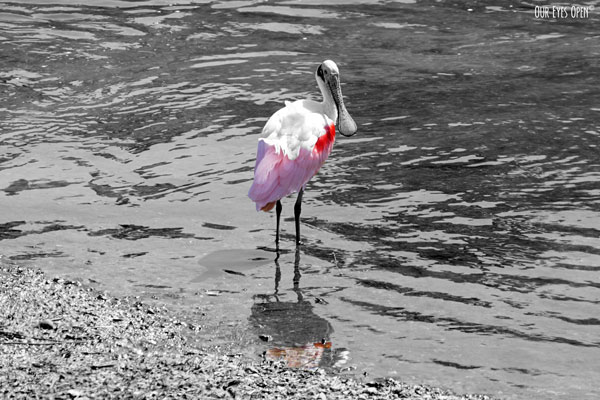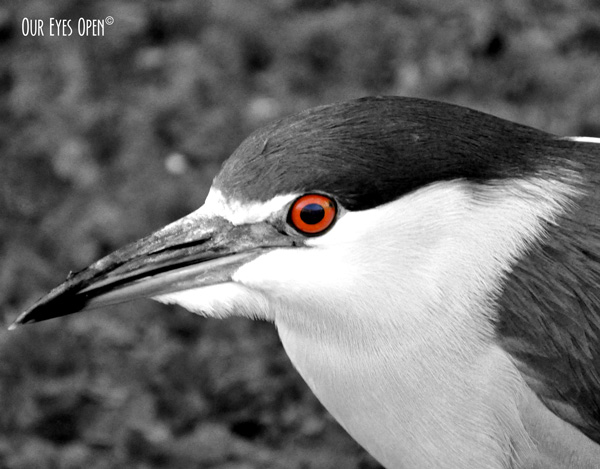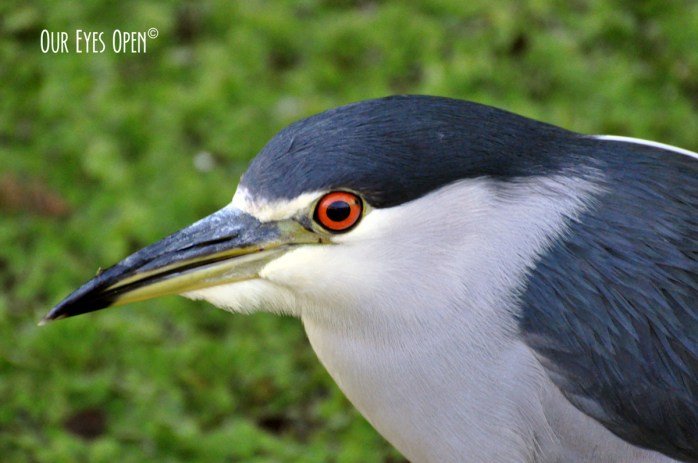Welcome to Week #49 of the Bird Weekly Photo Challenge. Week #49 challenge is birds using selective color with most of the photo being monochrome, black and white or sepia tone. Your choice of birds.
The feature image is a Laughing Gull approaching closer as we ate our picnic lunch on the beach at Little Talbot Island State Park. We don’t feed them, but if a chip blows out of our hands from the wind, we don’t rush to grab it from the sand.
Over the past week, I have shared some tutorials on how to perform selective colors in your photos using three different programs. I shared CorelPaint Pro 2021, Adobe Photoshop 2021 and Cee Nuener’s tutorials using Adobe Camera Raw. If you missed them and want to find out more, click on the following links:
There are many programs, some free and many mobile apps for you to use on your smart phones. I didn’t explore those options this time around, but maybe in the future. If you have a favorite and want to share, I would be up for discussing it for the next go round. We will be doing this again in the near future.
Black-crowned Night Heron
I thought I would leave my Black-crowned Night Heron in for this challenge. This is one of my all-time favorite photos and he has gotten around the blog a time or two.
Tricolored Heron

An adult Tricolored Heron’s face and beak will turn bright blue during the breeding season.
American Oystercatcher

The American Oystercatcher stands out even when I don’t use selective color. His red-yellow eyes and bright red-orange bill make this an easy bird to identify.
American Avocets

The graceful American Avocet is a black and white bird with a grayish head in non-breeding plumage. These two were breeding adults with the rusty head and neck.
Domestic Goose

Have you ever seen a blue eyed goose? I hadn’t until I saw this beauty at Floyd Lamb Park located near Las Vegas, Nevada. This domestic goose was not mean tempered like some domestic breeds.
Mallard

Male Mallards have so many beautiful colors. His bluish purple side tail feathers were tucked in or I would have added that color back in with the yellow, green and orange legs.
Domestic Muscovy Duck

With a face only a mother could love, this domestic Muscovy Duck lives at the cemetery with some other domestic geese, Mottled Ducks and Mallards.
White Ibis

White Ibises have this orange-red curved bill, but this one had a deeper red. This was one of two parents with one young nearby.
Verdin


Verdins are small grayish birds with a bright yellow patch on the head and a chestnut shoulder patch (not visible in this photo). I gave you a comparison for this one. He stands out either way. These are desert birds found in the Southwestern part of the United States.
Hooded Mergansers

These two male Hooded Mergansers had several females around them. I cropped the brown feathered girls out of the photo. The males have the striking yellow eyes and the breeding females have a cinnamon colored eye.
Turkey Vulture

Imagine if the Muscovy Duck and the Turkey Vulture mated….Okay maybe not! This redhead is nature’s vacuum cleaner. These birds are graceful in the sky and clunky on the ground, but they make the most of cleaning up roadkill.
Roseate Spoonbill

The Roseate Spoonbill is one of six species of spoonbills in the world and the only one found in the Americas. Their feathers turn pink from eating crustaceans and other aquatic invertebrates. The pigments in those food sources is called carotenoids.
Next time…Week #50 – Two or more bird species in one photograph. (6/4/21)




Comments
57 responses to “Bird Weekly – Photo Challenge – Birds Using Selective Color”
Reblogged this on About the Jez of It.
LikeLiked by 1 person
Thank you Jez! Appreciate it! Sorry I’m late with the reply. 🙂
LikeLiked by 1 person
Most welcome xx
LikeLiked by 1 person
🙂
LikeLike
Oh boy. I need to get busy for this one. Love the effect!
LikeLiked by 1 person
Thanks VJ. I’m catching up so I can’t wait to see what you got. 🙂
LikeLiked by 1 person
These are fab. A great sales pitch for making the effort to edit shots in this way.
LikeLiked by 1 person
Thanks Margaret! I get nothing for the pitch. I just want to get the info out there. 🙂
LikeLiked by 1 person
Love your finished images! I used to know how to do this but it’s been a while. It will be fun to re-learn how to do this.
LikeLiked by 1 person
Thanks Beth! I look forward to seeing them. It is a fun thing to do for sure. 🙂
LikeLiked by 1 person
[…] is my entry for Lisa’s from Our Eyes Open blog, Bird Weekly – Photo Challenge with the topic of Birds Using Selective […]
LikeLiked by 1 person
Lisa, you really nailed the eyes in these photos. Wonderful selective coloring for this week.
Here is my entry for the week.
LikeLiked by 1 person
Thanks Cee! The eyes get me everytime. This was so much fun especially after the stress of the week. I may be doing this on a semi-regular basis. 🙂
LikeLike
[…] is my entry for Lisa’s Bird Weekly – Photo Challenge with the topic of Birds Using Selective […]
LikeLiked by 1 person
Fabulous photos of these birds Lisa….here is mine…
https://100countrytrek.com/2021/05/28/bird-weekly-photo-challenge-birds-using-selective-color/
LikeLiked by 1 person
Thank you so much Anita! It was a fun challenges for sure! 🙂
LikeLike
Love this photo challenge Lisa.
LikeLiked by 1 person
Thank you Anita. It is one of my favorites! 🙂
LikeLike
[…] Lisa from Bird Weekly challenge truly challenges our skills in converting color pictures to black and white with a dab of color. I […]
LikeLiked by 1 person
This is great, Lisa! I am for sure going to check out the photo shop tutorial! Awesome bird photos!
LikeLiked by 1 person
Thank you so much! I’m sorry for the late reply. I got hacked on Friday afternoon and just got back on WP today. 🙂
LikeLiked by 1 person
Oh wow! That’s not good! No worries, we all have lives outside of blog world 😁
LikeLiked by 1 person
Thanks Lisa! Yes, but this was not even a vacation. LOL! 🙂
LikeLiked by 1 person
[…] For Lisa´s Bird Weekly Challenge. […]
LikeLiked by 1 person
Lovely shots of colour in these captures. Beautiful!
LikeLiked by 1 person
Thank you so much Maria! Loved your Mew Gull! 🙂
LikeLike
Very cool pictures. Several of them have more than one color. That is interesting. Did you do that in Photoshop or Bridge? I particularly liked the white goose with blue eyes and a multi colored bill. Here’s my post. Hope you like it, 🙂 https://alwayswrite.blog/2021/05/28/bird-weekly-dipping-birds-in-the-selective-color-processing-bath-using-ps-elements/
LikeLiked by 1 person
Thanks Marsha! Photoshop of course. 🙂
LikeLiked by 1 person
Of course! 🙂
LikeLiked by 1 person
LOL! 🙂
LikeLiked by 1 person
The American Avocet is a real beauty !
LikeLiked by 1 person
Yes, especially in those breeding colors. 🙂
LikeLike
those heron photos are great, and so is that spoonbill one…
LikeLiked by 1 person
Thanks Jim. I had fun with this challenge but haven’t been able to enjoy it since the Etsy wave. 🙂
LikeLiked by 1 person
that sounds like a good problem to have… 🙂
LikeLiked by 1 person
Yep a good problem to have. 🙂
LikeLiked by 1 person
I really like the roseate spoonbill!
LikeLiked by 1 person
Thanks Karen. It is one of our favorite birds to see. Never get tired of seeing pink flying in the sky. 🙂
LikeLike
Now that you mention it, there’s not much pink flying around Sydney. The odd galah, but few in areas where I’ve lived.
LikeLiked by 1 person
There isn’t much pink anywhere except a few areas all over the world. We are blessed to have them. 🙂
LikeLike
[…] theme for Bird Weekly Photo Challenge is selective color with most of the photo being monochrome, black and white or sepia […]
LikeLiked by 1 person
[…] For Bird Weekly’s Challenge: selective colour. […]
LikeLiked by 1 person
It’s really cool the different looks you can get with this technique
LikeLiked by 1 person
Yes it certainly is and it’s fun and creative. 🙂
LikeLiked by 1 person
[…] If you would like to join these challenges, you can find the info here – https://oureyesopen.blog/2021/05/28/bird-weekly-photo-challenge-birds-using-selective-color/ […]
LikeLiked by 1 person
Here is mine for the week
LikeLiked by 1 person
[…] Bird Weekly […]
LikeLiked by 1 person
[…] has set an unusual challenge for this week’s Bird Weekly, the selective colour editing of photos. It’s one that really attracted me to have a go. I love […]
LikeLiked by 1 person
It took me a while (this is fiddly work!) but I’ve finally got something to share with you: https://www.toonsarah-travels.blog/gallery-playing-with-a-selective-colour-technique/ There aren’t nearly as many photos as you have but I hope you like it. I’ve really appreciated being pushed by this challenge to learn how to do this. Your Photoshop instructions were very clear and I found I could follow them almost to the letter in Elements 🙂 As I say in my post, I’m in two minds as to whether I like the finished results as much as I thought I would, although I have to say yours are very effective. Perhaps I’ve just been peering at mine too closely for too long!
LikeLiked by 1 person
I think you are too hard on yourself. Your images turned out beautifully! Plus, the more you practice, the better you get. However, I would have never known this was the first time by looking at these photos. Hope you keep practicing and google other ways to do this for Photoshop Elements. There is always more than one way. 🙂
LikeLiked by 1 person
Yes, almost always there’s more than one way in PS! I learned some new stuff on a Camera Club Zoom earlier this week so I have something else to fiddle with now 😂
LikeLiked by 1 person
Yeah for the fiddle! LOL! 🙂
LikeLiked by 1 person
[…] Thanks to Lisa for her Bird Weekly Challenge: Birds using Selective Color […]
LikeLiked by 1 person
[…] Bird Weekly Challenge: Week #49 Birds using selective color. […]
LikeLiked by 1 person
Cattle Egret
http://robertsnapspot.com/2021/06/06/wildlife-birds-of-the-air-cattle-egret-in-fountain/
LikeLiked by 1 person
[…] week’s Birdweekly Challenge is to use selective color — pick one color of the bird and make the rest of the image […]
LikeLiked by 1 person
[…] Thanks to Lisa for her Bird Weekly Challenge: More than one Bird Species in a photo […]
LikeLiked by 1 person